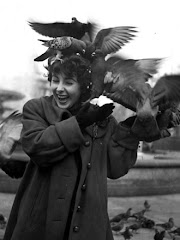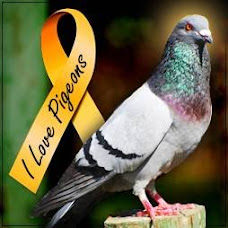

by EVOLVE! Campaigns
How old are pigeons?
Pigeons have lived alongside man for thousands of years with the first images of pigeons being found by archaeologists in Mesopotamia (modern Iraq) and dating back to 3000 BC. It was the Sumerians in Mesopotamia that first started to breed white doves from the wild pigeon that we see in our towns and cities today and this undoubtedly accounts for the amazing variety of colors that are found in the average flock of urban pigeons. To ancient peoples a white pigeon would have seemed miraculous and this explains why the bird was widely worshipped and considered to be sacred. Throughout human history the pigeon has adopted many roles ranging from symbols of gods and goddesses through to sacrificial victims, messengers, pets, food and even war heroes!
Biblical references
The first biblical reference to the pigeon (or dove) was in the Old Testament of the Bible in the first millennium AC and was the story of Noah and the dove of peace. Later, in the New Testament, the pigeon was first mentioned during the baptism of Christ where the dove descended as the Holy Spirit, an image now used extensively in Christian art. These early biblical references have paved the way for the many different ways that the urban pigeon is viewed in modern societies worldwide. Perception of the pigeon through the centuries has changed from God to the devil and from hero to zero!
Pigeon poop – foul or fantastic?
Although pigeon poo is seen as a major problem for property owners in the 21st Century, it was considered to be an invaluable resource in the 16th, 17th and 18th century in Europe. Pigeon poop was a highly prized fertiliser and considered to be far more potent than farmyard manure. So prized in fact that armed guards were stationed at the entrances to dovecotes (pigeon houses) to stop thieves stealing it! Not only this, but in England in the 16th century pigeon poop was the only known source of saltpetre, an essential ingredient of gunpowder and was considered a highly valued commodity as a result. In Iran, where eating pigeon flesh was forbidden, dovecotes were set up and used simply as a source of fertilizer for melon crops and in France and Italy it was used to fertilize vineyards and hemp crops.
The pigeon as a war hero
In modern times the feral pigeon has been used to great effect during wartime. In both the first and second World Wars the pigeon saved hundreds of thousands of human lives by carrying messages across enemy lines. Pigeons were carried on ships in convoys and in the event of a U-boat attack a messenger pigeon was released with details of the location of the sinking ship. In many cases this lead to the survivors being rescued and lives saved. Mobile pigeon lofts were set up behind the trenches in the First World War from which pigeons often had to fly through enemy fire and poison gas to get their messages home. The birds played a vital role in intelligence gathering and were used extensively behind enemy lines where the survival rate was only 10%. In the Second World War pigeons were used less due to advances in telecommunications, but the birds relayed invaluable information back to the allies about the German V1 and V2 Rocket sites on the other side of the Channel.
The pigeon as a messenger
The earliest large scale communication network using pigeons as messengers was established in Syria and Persia about 5th Century BC. Much later in the 12th Century AD the city of Baghdad and all the main towns and cities in Syria and Egypt were linked by messages carried by pigeons. This was the sole source of communication. In Roman times the pigeon was used to carry results of sporting events such as the Olympic Games and this is why. Games and this is why white doves are released at the start of the Olympic Games today. In England, prior to the days of telegraphs, pigeons were often taken to soccer matches and released to carry home the result of the game. Their use as a messenger in war time resulted in many pigeons being awarded honors by both the British and French Governments. Incredibly, the last ‘pigeon post’ service was abandoned in India in 2004 with the birds being retired to live out the rest of their days in peace.
'Rock Dove' or 'Pigeon
The feral pigeon that we see in our towns and cities today is descended from the Rock Dove (Columba livia), a cliff dwelling bird historically found in coastal regions. The word ‘pigeon’ is actually derived from the Latin word ‘pipio’ which meant ‘young bird’. The word then passed into Old French as ‘pijon’ and thus the English name ‘pigeon’ was derived and is now used the world over as a common name for the Rock Dove. Other common names include ‘domestic pigeon’ and the ‘feral pigeon’. In 2004 British and American Ornithologists officially re-named the bird the Rock Pigeon.
Mating habits of the pigeon
The feral pigeon mates for life and can breed up to 8 times a year in optimum conditions, bringing two young into the world each time. The frequency of breeding is dictated by the abundance of food. The eggs take 18/19 days to hatch with both parents incubating the eggs. Young dependant pigeons are commonly known as ‘squabs’. Both parents feed the young with a special ‘pigeon milk’ that is regurgitated and fed to the squabs. Each squab can double its birth weight in one day but it takes 4 days for the eyes to open. When squabs are hungry they ‘squeak’ whilst flapping their wings and as a result they are also commonly known as ‘squeakers’. At approximately 2 months of age the young are ready to fledge and leave the nest. This much longer than average time spent in the nest ensures that life expectancy of a juvenile pigeon is far greater than that of other fledglings.
How do pigeons navigate?
There are many theories about how pigeons manage to return ‘home’ when released 100’s of miles from their loft. A champion racing pigeon can be released 400-600 miles away from its home and still return within the day. This amazing feat does not just apply to ‘racing’ or ‘homing’ pigeons, all pigeons have the ability to return to their roost. A 10-year study carried out by Oxford University concluded that pigeons use roads and freeways to navigate, in some cases even changing direction at freeway junctions. Other theories include navigation by use of the earth’s magnetic field, visual clues such as landmarks, the sun and even infrasounds (low frequency seismic waves). Whatever the truth, this unique ability makes the pigeon a very special bird.
Pigeons as lifesavers
Although pigeons are one of the most intelligent of all the bird species man has found limited uses for the birds other than for the purposes of sport, food and as a message carrier. A team of navy researchers, however, has found that pigeons can be trained to save human lives at sea with high success rates. Project Sea Hunt has trained a number of pigeons to identify red or yellow life jackets when floating in the water. The pigeons were not only found to be more reliable than humans but they were also many times quicker than humans when it came to spotting survivors from a capsized or sinking boat. The pigeon can see color in the same way that humans do but they can also see ultra-violet, a part of the spectrum that humans cannot see, and this is one of the reasons they are so well adapted to lifesaving.
Pigeons in the news
One of the world’s most famous news agencies, Reuters, started its European business by using trained homing pigeons. The service was started in 1850 with 45 pigeons carrying the latest news and stock prices from Aachen in Germany to Brussels in Belgium. Although a telegraph service between the two countries existed, numerous gaps in the transmission lines made communication difficult and slow. The birds travelled the 76 miles in a record-breaking two hours beating the railway by four hours.
Why do you never see a baby pigeon?
Most small birds rear and fledge their young in 2/3 weeks with young birds sometimes leaving the nest after only 10 days of life, but pigeons are different, their young remain in the nest for up to 2 months before fledging. This gives the young pigeon an advantage over many other species of bird. It leaves the nest as a relatively mature juvenile, allowing the bird to cope better in the first few days of its life, a dangerous time for all youngsters. Juveniles can be told apart from adults but it takes an experienced eye. A juvenile’s beak often appears to be far too long for the size of its body and the cere (the fleshy area at the top of the beak) is white in adults and greyish pink in juveniles.
Are Pigeons Intelligent?
Pigeons are considered to be one of the most intelligent birds on the planet with pigeons being able to undertake tasks previously thought to be the sole preserve of humans and primates. The pigeon has also been found to pass the ‘mirror test’ (being able to recognise its reflection in a mirror) and is one of only 6 species, and the only non-mammal, that has this ability. The pigeon can also recognise all 26 letters of the English language as well as being able to conceptualise. In scientific tests pigeons have been found to be able to differentiate between photographs and even differentiate between two different human beings in a photograph when rewarded with food for doing so.












No comments:
Post a Comment